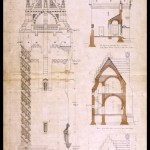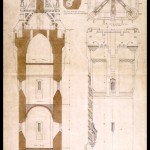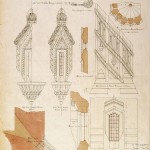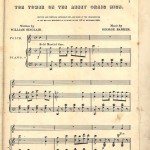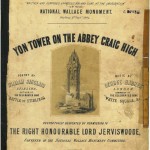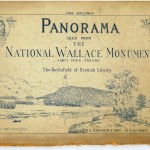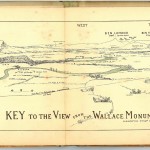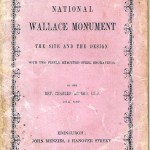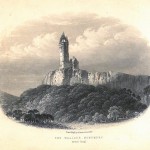Within the Stirling Burgh collection at Stirling Council Archives there are some very special architectural plans of the Wallace Monument. Recently conserved, the original plans by architect Thomas Rochead were cleaned and digitised in 2013.
Whilst the Wallace Monument is one of Stirling’s most iconic buildings and remains one Scotland’s most popular tourist attractions, the story of its erection was beset with controversies. In 1850 a movement developed in Stirling to commemorate William Wallace and build a permanent monument to him. The initial campaign to erect a monument has been credited to Rev. Charles Roger. Roger, a Chaplain of Stirling Castle, managed to set in motion efforts to raise support and money for a national monument. This led to a design competition, fundraising events and a ‘National Meeting’ in the King’s Park on the 24th of June 1856. Abbey Craig was selected as the preferred location for the monument. This was where many believed Wallace had oversaw the Battle of Stirling and it was considered, geographically, the centre of Scotland.
The project, however, was controversial from the start. Many were against were the erection of the monument and the project was plagued by financial issues. Unlike other national monuments, the Wallace Monument was funded by contributions from the public rather than by government. For this reason, fundraising was difficult to the extent that on more than one occasion it was questionable whether the monument would ever be completed.
The design competition was won by John Thomas Rochead of Glasgow. Relatively unknown at the time, Rochead had previously won architectural design competitions including for ‘The Royal Arch’ in Dundee and St Mary’s Free Church in Edinburgh. Arguments, however, arose from the competition. Rochead’s design was deemed to be coloured contrary to the conditions of the competition, leading to a complaint from the Glasgow Architectural Society about the contest.
The foundation stone for the monument was laid on 24th of June 1861 by the Duke of Atholl to wide public enthusiasm. Thousands headed to the area to celebrate the occasion with more than 80,000 people arriving at the event. When the monument was finally inaugurated in 1869, after eight years of building work, it was seriously over budget. Rochead exceeded the cost limit by £5,000 and the contractor, Mr Harvie of Hamilton, would become bankrupt. John Thomas Rochead would never receive his fees. Even after his death in 1878, the monument was still causing controversy as Rochead’s widow unsuccessfully pressed the Custodier for her husband’s fees until her death in 1896.
The inauguration ceremony was described by the Stirling Observer as a ‘striking contrast to the memorable event when the foundation stone was laid.’ A formal ceremony was held in the Armoury Hall of the monument. Evening celebrations included the illumination of the monument followed by 30 minutes of fireworks. There was even a ‘new national song’ composed by William Sinclair. Titled ‘Yon tower on the Abbey Craig High’ it was specifically composed to be sung on the occasion of the inauguration.
Despite the fiasco concerning the monument’s construction, the Wallace Monument inspired many with its views. Publications, such as R.S. Shearer and Son’s ‘Panorama seen from the National Wallace Monument’, highlighted the spectacular views from the top which can still be enjoyed today.
